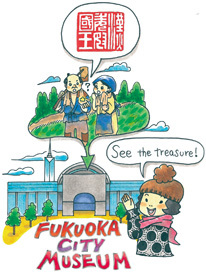Hakata Culture vol.33
The story of the Gold Seal

Most of the business cards used by the municipal employees of Fukuoka City are printed with a shiny mark. Whenever they distribute the cards, the recipients invariably ask if that mark represents is the gold seal. That’s right―the gold seal is Fukuoka City’s only national treasure, and it is formally referred to as the Kan no Wa no Na no Kokuo. It was discovered on the Shikanoshima in Hakata Bay in February 1784 by someone engaged in agricultural work. To be precise, the seal surface is a rather small 2.347 centimeters square, and the seal on the municipal employees’ business cards is the same size. The seal itself weighs 108 grams.
Research into the real nature of the seal, which has a coiled snake depicted on the knob, was conducted by the noted Edo period scholar Nanmei Kamei, who lived in Tojin-machi, a castle town. The seal matches the description in the Hohanshu, an ancient Chinese historical record, a seal presented by the Emperor Gwang Wu to the chief government official of northern Kyushu when the latter visited China in the year 57. The official name contains the name of the Chinese dynasty, followed by the name of the ethnic group and the tribe. The “Wa no Na” refers to the “tribe” of the Japanese.
The seal was given to the Kuroda family, the feudal lords of the Fukuoka domain. It was then presented to Fukuoka City in 1978 when the Fukuoka Art Museum was built. It is now in the collection of the Fukuoka City Museum in Momochihama, where it is on display.
The government designated the gold seal a national treasure in 1954. In 1973 and 1974, the Fukuoka City Education Committee and Kyushu University conducted exploratory excavations at the site where it was said to have been discovered. That site is now the Kinin Park. Many tourists mistakenly believe the seal is on display at the park, but I’ve been asked to be sure to tell people to find it at the Fukuoka City Museum.
Disputes remain about who discovered the seal, where it was discovered, and the characters on its face. It’s still full of secrets after all these years!
A public relations manager
Kimiyo Sasaki![]() FUKUOKA CITY MUSEUM
FUKUOKA CITY MUSEUM
金印が発見されました!
福岡市職員が持っている名刺のほとんどには光り輝くマークが印刷されています。これを渡すとこれまたほとんどの方が「ああ、これが金印ですか?」と問われます。そう、福岡市が誇る最も有名なモノ、それが金印きんいん「漢委奴国王」と呼ばれています。江戸時代の天明4年(1784)2月、博多湾に浮かぶ志賀島で農作業中に発見されたといわれます。印面は正確に2.347センチ四方で市職員の名刺に刷られているのと同じ大きさで、小さいものです。重量は108グラム、つまみに蛇のとぐろのある金印は江戸時代の大学者で城下町、唐人町に住んでいた亀井南冥によって研究され、金印の正体が解き明かされました。
その正体とは、中国の史書『後漢書』中に記載されている「建武中元2年(57)、光武帝がはるばる訪れてきた北部九州の首長に贈った印綬」と書かれていたものとぴったり一致するというものです。始めに中国の王朝名、次ぎに民族名、部族名の順番で、委奴というのは委族(日本人)の奴(部族)という意味だそうです。金印は当時の福岡藩主・黒田家に伝わり、福岡市美術館が完成するのをきっかけに、1978年、福岡市に寄贈されました。現在は百道浜の福岡市博物館で保管・展示されています。
金印が国宝に指定されたのは、1954年のこと。その後1973年、1974年に福岡市教育委員会と九州大学によって、金印が出土したといわれるところで発掘調査が行われ、現在の金印公園となりました。この金印公園に金印があると勘違いしている観光客が多いので、本物の金印は福岡市博物館にあるということをぜひ教えてあげてください。
この金印に関しては、出土地や発見した人、印面の文字に関してなど、いまだに論争があっているとか。まだまだ謎が多い金印なのであります。
福岡市広報課長 佐々木 喜美代![]() 福岡市博物館ホームページ
福岡市博物館ホームページ

